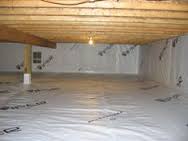Post Frame Home Zero Barrier Entry Over a Crawl Space
Reader MARC in AUBURN writes:
“I am asking what might be an odd question, but I need to ask it to see if it is even an option.
Is it possible to build a post frame home with part of it having a concrete floor (garage area) and the other part be built on a raised wood joist subfloor spring that I have a 4 foot crawl. The trick is, I want zero barrier entry so the sub floor and the garage floor would need to be level. Same with porches, etc. is this doable without building an actual foundation wall around the home section? I want to avoid traditional foundations and want to rely on the superior properties of a properly engineered and constructed post frame building. Am I better off just going all slab without a crawl?
Thank you!”
 Not an odd question at all and yes it is an option. I (and my knees) personally prefer to live on wood floors, rather than concrete. Our household also relates to zero barrier entry as my lovely bride Judy is a paraplegic confined to a wheelchair.
Not an odd question at all and yes it is an option. I (and my knees) personally prefer to live on wood floors, rather than concrete. Our household also relates to zero barrier entry as my lovely bride Judy is a paraplegic confined to a wheelchair.
We can design your living space using permanent wood foundation walls between roof supporting pressure preservative treated columns.
Treated wood foundations are load-bearing, pressure-treated wood framed walls, used below grade to support light frame construction. Treated wood foundations are commonly called Permanent Wood Foundations or All-Weather Wood Foundations. Since being developed in the 1960s, this unique building system has proven to be a durable building system in thousands of physical applications. Treated wood foundations have undergone extensive research, analysis, and testing by several highly respected building construction industry organizations. They have been approved for use by model building codes, federal agencies, and by lending, warranty and insurance institutions. A treated wood foundation, when installed, waterproofed, and drained properly, and used in conjunction with other waterproof materials, is a viable alternative to poured concrete or concrete block foundations. When I added onto my home near Spokane, Washington 30 years ago, I utilized pressure preservative treated wood as a foundation around an irregular crawl space supporting two floors and cantilevered decks above. It has performed admirably, even in a severe lakefront environment.
Treated wood foundations are built on most types of soils (Group I – III), with an exception of unsatisfactory soils (Group IV) as defined by the U.S. Department of Agriculture. Group IV soils typically have over 40% clay, less than 50% sand and may have a high shrink-swell potential. Similar to conventional foundation systems, sites should be cleared of organic material and top soil prior to work onset. Crawl space is then excavated, and a footing is placed on undisturbed soil below frost line. Footings under a treated wood foundation wall can be made of poured concrete or a wood footing plate on top of granular fill. In my case, I used a poured concrete footing, however in your instance, since vertically carried loads would be minimal, gravel should prove more than sufficient. as footing size is engineered based on foundation wall loads. Adequate, unobstructed drainage around a treated wood foundation is achieved by having continuous granular fill on building sides and underneath structure. Granular material can be up to 1/2 inch crushed stone, 3/4 inch gravel or 1/16 inch sand depending on where it is intended to be used. All granular material should be clean and free of silt, clay and organic material, and be covered with a 6-mil polyethylene sheeting. Sump pumps, perimeter drains, and dry wells may be used under your crawl space floor and around the exterior to promote drainage. Storm water control including gutters, downspouts, splash blocks and drainpipes, in addition to a properly sloped finish grade, is also important to direct water away from the structure.
Materials used to construct treated wood foundations include: plywood, preservative treated lumber, fasteners, termite protection (where appropriate), a moisture barrier, sealing, and insulation. All framing lumber below grade in a treated wood foundation is required to be pressure treated with preservatives in accordance with the American Wood Preservers’ Association (AWPA) Standard C22, “Lumber and Plywood for Permanent Wood Foundations – Preservative Treatment by Pressure Processes.” An important consideration when building a treated wood foundation is the metal used in the fasteners. Due to the high levels of copper in wood preservatives, fasteners are required to be a corrosion-resistant. Type 304 or 316 stainless steel nails are recommended.
An essential part of a treated wood foundation system is moisture and termite protection. In addition to a 6-mil polyethylene sheet wrapped around exterior plywood sheathing, all sheathing joints must be caulked with a high-performance acrylic latex or polyurethane caulk. Preservative treated wood eliminates termites from crawl space framing, because termites cannot penetrate it; however, additional steps should be taken to protect untreated floors above.
Several advantages make treated wood foundations an attractive option. Construction of a treated wood foundation is simple to erect, in comparison to concrete foundations. Treated wood foundations also offer advantages over concrete foundations such as an ability to install insulation between studs, affording a higher R-Value in comparison to uninsulated concrete foundation walls, leading to greater energy efficiency.






